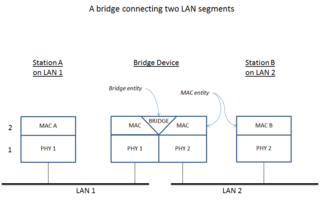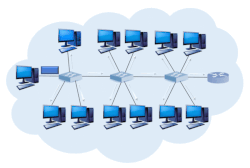
In computer networking, multicast is group communication where data transmission is addressed to a group of destination computers simultaneously. Multicast can be one-to-many or many-to-many distribution. Multicast should not be confused with physical layer point-to-multipoint communication.
Multiprotocol Label Switching (MPLS) is a routing technique in telecommunications networks that directs data from one node to the next based on labels rather than network addresses. Whereas network addresses identify endpoints, the labels identify established paths between endpoints. MPLS can encapsulate packets of various network protocols, hence the multiprotocol component of the name. MPLS supports a range of access technologies, including T1/E1, ATM, Frame Relay, and DSL.
A virtual local area network (VLAN) is any broadcast domain that is partitioned and isolated in a computer network at the data link layer. In this context, virtual refers to a physical object recreated and altered by additional logic, within the local area network. VLANs work by applying tags to network frames and handling these tags in networking systems – creating the appearance and functionality of network traffic that is physically on a single network but acts as if it is split between separate networks. In this way, VLANs can keep network applications separate despite being connected to the same physical network, and without requiring multiple sets of cabling and networking devices to be deployed.
A virtual private network (VPN) is a mechanism for creating a secure connection between a computing device and a computer network, or between two networks, using an insecure communication medium such as the public Internet.
A multilayer switch (MLS) is a computer networking device that switches on OSI layer 2 like an ordinary network switch and provides extra functions on higher OSI layers. The MLS was invented by engineers at Digital Equipment Corporation.

Protocol-Independent Multicast (PIM) is a family of multicast routing protocols for Internet Protocol (IP) networks that provide one-to-many and many-to-many distribution of data over a LAN, WAN or the Internet. It is termed protocol-independent because PIM does not include its own topology discovery mechanism, but instead uses routing information supplied by other routing protocols. PIM is not dependent on a specific unicast routing protocol; it can make use of any unicast routing protocol in use on the network. PIM does not build its own routing tables. PIM uses the unicast routing table for reverse-path forwarding.
Packet forwarding is the relaying of packets from one network segment to another by nodes in a computer network. The network layer in the OSI model is responsible for packet forwarding.
In computer networking, a media access control attack or MAC flooding is a technique employed to compromise the security of network switches. The attack works by forcing legitimate MAC table contents out of the switch and forcing a unicast flooding behavior potentially sending sensitive information to portions of the network where it is not normally intended to go.
Virtual Private LAN Service (VPLS) is a way to provide Ethernet-based multipoint to multipoint communication over IP or MPLS networks. It allows geographically dispersed sites to share an Ethernet broadcast domain by connecting sites through pseudowires. The term sites includes multiplicities of both servers and clients. The technologies that can be used as pseudo-wire can be Ethernet over MPLS, L2TPv3 or even GRE. There are two IETF standards-track RFCs describing VPLS establishment.
IP multicast is a method of sending Internet Protocol (IP) datagrams to a group of interested receivers in a single transmission. It is the IP-specific form of multicast and is used for streaming media and other network applications. It uses specially reserved multicast address blocks in IPv4 and IPv6.

A network bridge is a computer networking device that creates a single, aggregate network from multiple communication networks or network segments. This function is called network bridging. Bridging is distinct from routing. Routing allows multiple networks to communicate independently and yet remain separate, whereas bridging connects two separate networks as if they were a single network. In the OSI model, bridging is performed in the data link layer. If one or more segments of the bridged network are wireless, the device is known as a wireless bridge.
Provider Backbone Bridge Traffic Engineering (PBB-TE) is a computer networking technology specified in IEEE 802.1Qay, an amendment to the IEEE 802.1Q standard. PBB-TE adapts Ethernet to carrier class transport networks. It is based on the layered VLAN tags and MAC-in-MAC encapsulation defined in IEEE 802.1ah, but it differs from PBB in eliminating flooding, dynamically created forwarding tables, and spanning tree protocols. Compared to PBB and its predecessors, PBB-TE behaves more predictably and its behavior can be more easily controlled by the network operator, at the expense of requiring up-front connection configuration at each bridge along a forwarding path. PBB-TE Operations, Administration, and Management (OAM) is usually based on IEEE 802.1ag. It was initially based on Nortel's Provider Backbone Transport (PBT).
A broadcast storm or broadcast radiation is the accumulation of broadcast and multicast traffic on a computer network. Extreme amounts of broadcast traffic constitute a broadcast storm. It can consume sufficient network resources so as to render the network unable to transport normal traffic. A packet that induces such a storm is occasionally nicknamed a Chernobyl packet.
A forwarding information base (FIB), also known as a forwarding table or MAC table, is most commonly used in network bridging, routing, and similar functions to find the proper output network interface controller to which the input interface should forward a packet. It is a dynamic table that maps MAC addresses to ports. It is the essential mechanism that separates network switches from Ethernet hubs. Content-addressable memory (CAM) is typically used to efficiently implement the FIB, thus it is sometimes called a CAM table.
In network routing, the control plane is the part of the router architecture that is concerned with establishing the network topology, or the information in a routing table that defines what to do with incoming packets. Control plane functions, such as participating in routing protocols, run in the architectural control element. In most cases, the routing table contains a list of destination addresses and the outgoing interface(s) associated with each. Control plane logic also can identify certain packets to be discarded, as well as preferential treatment of certain packets for which a high quality of service is defined by such mechanisms as differentiated services.
IEEE 802.1aq is an amendment to the IEEE 802.1Q networking standard which adds support for Shortest Path Bridging (SPB). This technology is intended to simplify the creation and configuration of Ethernet networks while enabling multipath routing.
TRILL is an Internet Standard implemented by devices called TRILL switches. TRILL combines techniques from bridging and routing, and is the application of link-state routing to the VLAN-aware customer-bridging problem. Routing bridges (RBridges) are compatible with and can incrementally replace previous IEEE 802.1 customer bridges. TRILL Switches are also compatible with IPv4 and IPv6, routers and end systems. They are invisible to current IP routers, and like conventional routers, RBridges terminate the broadcast, unknown-unicast and multicast traffic of DIX Ethernet and the frames of IEEE 802.2 LLC including the bridge protocol data units of the Spanning Tree Protocol.
In computer networking, a unicast flood is when a switch receives a unicast frame from an unknown sender and treats it as a broadcast frame, flooding the frame to all other ports on the switch.
Virtual Extensible LAN (VXLAN) is a network virtualization technology that attempts to address the scalability problems associated with large cloud computing deployments. It uses a VLAN-like encapsulation technique to encapsulate OSI layer 2 Ethernet frames within layer 4 UDP datagrams, using 4789 as the default IANA-assigned destination UDP port number. VXLAN endpoints, which terminate VXLAN tunnels and may be either virtual or physical switch ports, are known as VXLAN tunnel endpoints (VTEPs).

Multicast routing is one of the routing protocols in IP networking.







